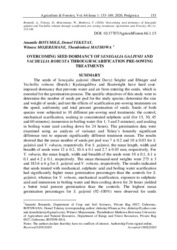| dc.contributor.author | Boitumelo, Amantle | |
| dc.contributor.author | Teketay, Demel | |
| dc.contributor.author | Mathowa, Thembinkosi | |
| dc.date.accessioned | 2022-02-17T10:15:33Z | |
| dc.date.available | 2022-02-17T10:15:33Z | |
| dc.date.issued | 2020-03-30 | |
| dc.identifier.citation | Botumile, A., Teketay, D., Mojeremane, W., & Mathowa, T. (2020). Overcoming seed dormancy of Senegalia galpinii and Vachellia robusta through scarification pre-sowing treatments. Agriculture & Forestry/Poljoprivreda i Sumarstvo, 66(1). | en_US |
| dc.identifier.other | 216254775 | |
| dc.identifier.uri | DOI:10.17707/agricultforest.66.1.15 | |
| dc.identifier.uri | https://pdfs.semanticscholar.org/67c7/ae6f55bc4451ec893b6bed6da60b70122511.pdf?_ga=2.202011921.1279297262.1645091395-934403594.1619517704 | |
| dc.identifier.uri | https://researchhub.buan.ac.bw:80/handle/13049/356 | |
| dc.description | The article is licensed under the Creative Commons Attribution 4.0 International License | en_US |
| dc.description.abstract | The seeds of Senegalia galpinii (Burtt Davy) Seigler and Ebinger and Vachellia robusta (Burch.) Kyalangalilwa and Boatwright have hard coatimposed dormancy that prevents water and air from entering the seeds, which is essential for the germination process. The specific objectives of this study were to determine the number of seeds per pod for the study species; determine the size and weight of seeds; and test the effects of scarification pre-sowing treatments on the speed, uniformity and total percent germination of seeds. Seeds of both species were subjected to 10 different pre-sowing seed treatments: the control, mechanical scarification, soaking in concentrated sulphuric acid (for 15, 30, 45 and 60 minutes), immersion in boiling water (for 1, 3 and 5 minutes), and soaking in boiling water (and cooling down for 24 hours). The germination data were examined using an analysis of variance and Tukey’s honestly significant difference test to separate significantly different treatment means. The results showed that the mean number of seeds per pod was 7 ± 0.2 and 10 ± 0.03 for S. galpinii and V. robusta, respectively. For S. galpinii, the mean length, width and breadth of seeds were 12 ± 0.2, 10.4 ± 0.1 and 2.7 ± 0.03 mm, respectively. For V. robusta, the mean length, width and breadth of the seeds were 10 ± 0.1, 6.1 ± 0.1 and 4.2 ± 0.1, respectively. The mean thousand-seed weights were 275 ± 3 and 183.6 ± 6 g for S. galpinii and V. robusta, respectively. The results indicated that seeds treated with mechanical, sulphuric acid and boiling water scarification had significantly higher mean germination percentages than the controls for S. galpinii, whereas for V. robusta, mechanical scarification, exposure to sulphuric acid and immersion in boiling water and then cooling down for 24 hours yielded a better total percent germination than the controls. The highest mean germination percentages for S. galpinii (92–100%) were observed for seeds. | en_US |
| dc.language.iso | en | en_US |
| dc.publisher | Semantic Scholar | en_US |
| dc.relation.ispartofseries | Agriculture & Forestry/Poljoprivreda i Sumarstvo;66(1). | |
| dc.subject | Dormancy | en_US |
| dc.subject | Germination percentage | en_US |
| dc.subject | Pre-sowing treatments | en_US |
| dc.subject | Seed size | en_US |
| dc.subject | Seed weight | en_US |
| dc.title | Overcoming seed dormancy of senegalia galpinii and vachellia robusta through scarification pre-sowing treatments. | en_US |
| dc.type | Article | en_US |

